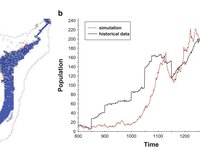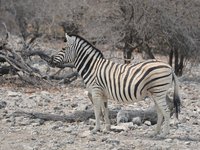Complex Adaptive Systems
The term gained momentum after Holland and Miller (1991).
A complex system:
- consists of a network of interacting agents (processes, elements)
- exhibits a dynamic, aggregate behavior that emerges from the individual activities of the agents
- can be described in its aggregate behaviour without a detailed knowledge of the behavior of the individual elements
An agent in such a system is adaptive if it satisfies an additional pair of criteria:
- the actions of the agent in its environment can be assigned a value (performance, utility, payoff, fitness, or the like)
- the agent behaves so as to increase this value over time
A complex adaptive system, then, is a complex system containing adaptive agents, networked so that the environment of each adaptive agent includes other agents in the system.
The Ansazi Project: Replicating History with an Artificial Society
- The perhaps best known analysis of archaeological history by means of an agent-based model
- Adopting one of the first ABMs from economics, Sugarscape (Epstein and Axtell, 1996), to archaeology (Axtell et al., 2002; Dean et al., 2000, 1998).
- Archaeological records were used to calibrate the model.
- See Swedlund et al., 2015 for a recent discussion of the project.
If you didn’t grow it, you didn’t explain its emergence (Epstein, 1999)
In a self-organizing system order is not imposed from the outside, by external influences. No architect or foreman holds the blue-print or has a preconceived idea about what patterns will evolve. The patterns that arise are emergent properties, properties that cannot be predicted simply by examining the subunits in isolation. To understand them, the dynamic and often remarkably complex interactions among the subunits must be taken into account.
Camazine 2003, Natural History
The Zebra‘s pattern is the result of a localised biochemical process and can easily be replicated with a cellular automaton, the precursor of agent-based models.
Goals of an Agent-based Approach to Archaeology
Improve Understanding / Enforcing Conceptual Clarity
- need to formalise all relevant aspects
- ‘bottom-up” approach reduces complexity of model building
- black-box (sub-)models can be used as surrogates / place holder
- theory-grounded causal explanations feed behavioural rules
- need to take other disciplines into account
- to provide necessary data and input (ecology, geology, . . . )
- to provide theory (sociology, economics, anthropology, . . . )
- possibility to play with alternatives
- test robustness with respect to input uncertainty
- implement and test conflicting theories
Communication
- Produce a coherent story with an enriched record.
Test Existing Theory
- conceptual level
- Is it possible to build a formal model of the theory?
- practical level (hypothesis testing)
- Are the predictions of the theory in line with the data?
- Is it possible to build a formal, working model that is in line with the empirical evidence / other (well-tested?) theory?
Generate Hypothesis
- as a consequence of ‘black-box” models
- as a consequence of the model building process itself
- as a consequence of falsification of existing theory
- predictive modelling: find potential excavation sites
Agent-based Modelling and Complexity Economics for Archaeology?!
- Economics is interested in the production, allocation and consumption of material goods and also services, but mainly in present time.
- Archaeological evidence, both indirect (e.g., land-use change) or direct (e.g., material artefacts) are part of the economic systems of our past.
- Economic theory is not limited to market-economies.
- Complexity Economics is transdisciplinary.
- Economic Methodology may in turn gain from such a task.
Pure Agent-based Computational Economics (Schaff, 2016) meets Archaeology
Pure agent-based computational economics (pACE) is the representation of economic theory by means of an agent-based model that embraces the concepts of ontology, epistemology and systemism.
Agent-based modelling is a simulation method that:
- allows to represents single entities of the system under study as single, and in principle even unique, objects called agents,
- allows these agents to interact on the local and global scale,
- allows for an explicit topology (i.e., space, distance) for both, physical and metaphysical concepts (e.g., friendship, reputation) and
- allows the state-space to change dynamically and in principle unbound (e.g, the number of agents, but also the relation between agents).
he ontological concept entails the representation of:
- economic actors as individual and potentially heterogeneous agents with an appropriate degree of disaggregation,
- the relevant economic environment with its different dimensions of space (time, geographic, cognitive, etc.),
- the relevant modes of interaction,
- the possible modes of economic action and
- an enveloping action-time framework.
The epistemological concept entails an explicit representation of:
- knowledge, i.e. the way in which information is stored and can be accessed,
- perception, i.e. the way in which information is perceived,
- communication, i.e. the way in which information is diffused among individuals and
- rationality, i.e. the way in which the individual agent makes use of its knowledge representation to decide on its actions.
The systemic concept entails the explicit representation of time, action and interaction, i.e. who acts when and how does this action of the single agent influence the environment, the agent itself and other agents.
References
Axtell, R. L., Epstein, J. M., Dean, J. S., Gumerman, G. J., Swedlund, A. C., Harburger, J., Chakravarty, S., Hammond, R., Parker, J., and Parker, M. (2002). Population growth and collapse in a multiagent model of the Kayenta Anasazi in Long House Valley. Proceedings of the National Academy of Sciences of the United States of America, 99 Suppl 3:7275–7279.
Camazine, S. (2003). Patterns in nature. Natural history, 112(5):34–41.
Clarke, D. L. (1972). Models and paradigms in contemporary Archaeology: Chapter 1. In Clarke, D. L., editor, Models in archaeology, pages 1–60. Methuen, London.
Dean, J., Gumerman, G., Epstein, J., Axtell, R., Swedlund, A., Parker, M., and McCarroll, S.(2000). Understanding Anasazi Culture Change Through Agent-Based Modeling: Chapter 7. In Kohler, T. and Gumerman, G., editors, Dynamics in Human and Primate Societies, pages 179–205. Oxford University Press.
Dean, J. S., Gumerman, G. J., Epstein, J. M., Axtell, R., Swedlund, A. C., Parker, M. T., and McCarroll, S. (1998). Understanding Anasazi Culture Change Through Agent-Based Modeling.
Epstein, J. M. (1999). Agent-based computational models and generative social science. Complexity, 4(5):41–60.
Epstein, J. M. and Axtell, R. (1996). Growing artificial societies: Social science from the bottom up; a product of the 2050 project, a collaborative effort of the Brookings Institution, the Santa Fe Institute, and the World Resources Institute. Complex adaptive systems. Brookings Inst. Press [u.a.], Washington and DC [u.a.].
Holland, J. H. and Miller, J. H. (1991). Artificial Adaptive Agents in Economic Theory. The American Economic Review, 81(2):365–370.
Schaff, F. (2016). Pure Agent-based Computational Economics of Time, Knowledge and Procedural Rationality with an Application to Environmental Economics. PhD thesis, FernUniversität in Hagen, Hagen.
Swedlund, A. C., Sattenspiel, L., Warren, A. L., and Gumerman, G. J. (2015). Modeling Archaeology: Origins of the Artificial Anasazi Project and Beyond. In Wurzer, G., Kowarik, K., and Reschreiter, H., editors, Agent-based Modeling and Simulation in Archaeology, Advances in Geographic Information Science, pages 37–52. Springer International Publishing, Cham and s.l.
Project informations
Ruhr-Universität Bochum, Lehrstuhl für Makroökonomie
06/2017 bis 05/2020
Deutsches Bergbau-Museum Bochum, Forschungsbereich Montanarchäologie
Ruhr-Universität Bochum, Institut für Archäologische Wissenschaften

